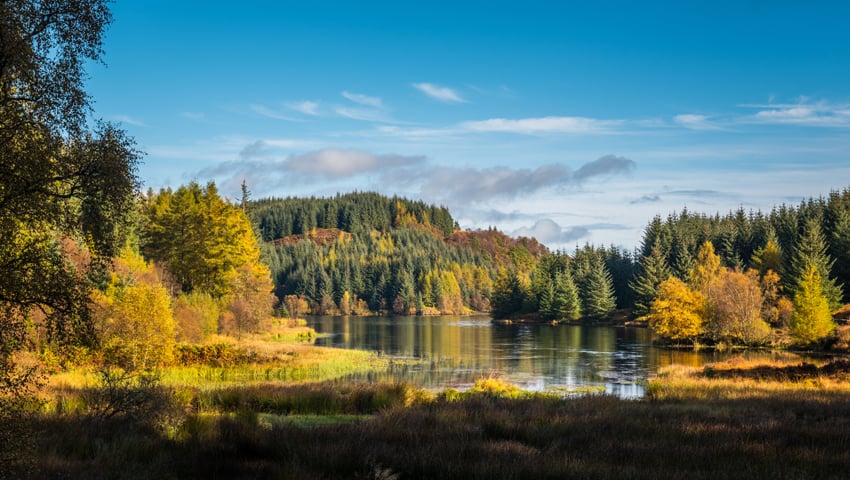An inspiring new quest has launched to unearth the stories and restoration potential of the country’s forgotten woodland sites.
If Scotland’s trees could talk, what would they say? A pilot project called Forgotten Woodlands from NatureScot, Forestry and Land Scotland, and Ainmean-Àite na h-Alba (the national advisory partnership for Gaelic place-names) has set out to map all Scottish place-names with the potential to reveal their historical woodland coverage. This, in turn, will hopefully inspire landowners and communities to think of the native trees their land used to support, and consider how they might wish to restore its ecological value for the future.
Rich in environmental and cultural detail, a digital story map has been created from the 15,000 place-names that Ainmean-Àite na h-Alba’s Dr Jake King has gathered during his research. The map allows the public to view and identify historically, culturally, and once-ecologically important woodland sites. Some of the areas with Gaelic place-names are still wooded, but of special interest are the areas of open ground with no records of previous land use beyond the linguistic clues left.
NatureScot Gaelic Officer Robyn Ireland said, “Much of Scotland used to be covered in forest. Today, native woodland covers just four percent of the total land area. Forgotten Woodlands shines a light on the strength of connection between Scotland’s natural and cultural diversity.
“The project is full of descriptions about place; without this knowledge of the language a place’s features can easily be hidden or, indeed, forgotten. The Forgotten Woodlands project demonstrates that there is ecological value in recognising, respecting and understanding the cultural context of Scotland. The longevity of woodlands in Scotland’s landscape speak of an ecological continuity that people recognised as significant and vital in previous centuries. There is a connection to be reclaimed and a privilege to be found in knowing what has gone before us, so that we can best take care of nature for the future.”
Ainmean-Àite na h-Alba’s Dr Jake King said, “This exciting and innovative project was akin to undertaking a PhD in 18 days! These 15,000 place-names, which contain words denoting ‘wood’, specific tree types, or woodland indicator species, are spread throughout mainland Scotland and derive from all languages of Scotland, not just Gaelic and Scots, but Pictish and Old Norse as well. When used in tandem with other existing datasets for Scotland’s woodlands, my hope is that the Forgotten Woodlands project will be a starting point for future research ideas and contribute a valuable ecological and cultural dimension to our existing knowledge.”
Forestry and Land Scotland Carbon Projects Manager Sarah Nicholas said, “Language has huge significance in our landscape. Many of the forests and land that we manage are steeped in folklore and bear Gaelic, Scots, Norse and Pictish names that describe their appearance or reflect their cultural importance. However, there has never been an attempt to comprehensively map woodland-related place-names across Scotland until now.
“We are proud to support the Forgotten Woodlands project because place-names can hold clues to help us understand the landscapes we manage. When viewed alongside ecological surveys, community consultations and other datasets, this piece of work can help inform decisions about its future management. Underpinned by our Gaelic Language Plan, this project is just one way that FLS is committed to helping ensure that the ongoing relevance of Gaelic is recognised and has a sustainable future.”
A Forgotten Woodlands Case Study: Glen Mallie Pinewood
Mapped as ‘An Giubhsach’- meaning ‘pine’ – on the Forgotten Woodlands database, the Glen Mallie Pinewood Restoration project will help protect one of the last remaining fragments of native Caledonian pinewood.
The Glen Mallie Pinewood is one of 84 recognised remaining fragments of the semi-natural Caledonian pinewood that once covered large areas of the Scottish Highlands.
Over time, these woodlands have been drastically reduced due to felling, fire, overgrazing and planting with non-native trees. Pinewoods are home to unique biodiversity found nowhere else in Britain, including capercaillie, twinflower and greenfoot tooth fungus, which are at risk of disappearing if the habitat continues to decline.
The western portion of the Glen Mallie Pinewoods is considered a ‘ghost woodland’, which means it has less than 20 per cent tree canopy cover and is at a critical point in its decline. The Gaelic name ‘An Giubhsach’ is another testament to the long history of woodland cover on this site, providing further evidence of its cultural and ecological significance.
In 2023, surveys by Future Woodlands Scotland found that there is natural regeneration present, following the woodland’s 1876 boundaries, but is being prevented from establishing by high numbers of red deer, highlighting the need urgent need for protection.
To address this, the Glen Mallie Restoration Project on Achnacarry Estate, supported by Future Woodlands Scotland and Scottish Forestry through the Scottish Forestry Grant Scheme, plans to fence off 250 hectares of the remaining Ghost Woodland to shield the regenerating trees from deer. This work will build on the restoration work being undertaken by the Woodland Trust and Arkaig Community Woodland in neighbouring pinewood areas as part of the Loch Arkaig Landscape Restoration Partnership – a focus project of the Alliance for Scotland’s Rainforest.
This will help a new generation of trees grow, stop the decline of these ancient woodlands and secure their long-term future. The project also aims to connect Glen Mallie with nearby woodlands and improve the resilience of the woodlands to climate change.
Kieran Leigh-Moy, Programme Manager at Future Woodlands Scotland, said, “Restoring the Glen Mallie Pinewood is crucial for protecting biodiversity and keeping a part of Scotland’s natural heritage alive. The veteran trees and plants show the history of a rich ecosystem that’s been here for centuries. Our approach will hopefully start the process of bringing the Glen Mallie Pinewoods back to life.”
View Scotland’s Forgotten Woodlands story map
